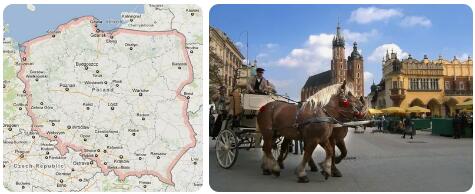Poland – Member of the European Union since 2004
In terms of area, Poland is one of the ten largest countries in Europe. Two thirds of it consists of lowlands that are less than 200 meters high. In addition to the Baltic Sea coast, the Pomeranian and Masurian Lake District are the country’s tourist areas. The southern third of Poland consists of mountains that have the character of low mountain ranges.
Poland’s longest river, the Vistula, flows past the most important cities: Krakow, Warsaw and Gdansk where the river flows into the Gdańsk Bay. After its extensive destruction in World War II, Warsaw emerged like a phoenix from the ashes. The construction was based on modern urban planning aspects, with historical buildings being exemplary reconstructed. The old town has been a UNESCO World Heritage Site since 1980.
Before the German occupation in 1939, there were around 3 million Jews in Poland. Around 90% of them were destroyed by the Nazis and many of the survivors fled abroad from the communists after the war. Therefore, only about 50,000 Jews live in the country today. But Jewish life is gradually starting to grow again, for example there were only 250 Jewish families in Warsaw in 2005, but by 2010 there were 600 – with eight rabbis.
One of the greatest tragedies after World War II occurred on April 10, 2010. On the morning of that day, the Polish presidential plane crashed shortly before the airport in Smolensk/Russia. 97 high-ranking representatives of the Polish political, military and economic elite were killed in the crash – including the country’s president – Lech Kaczynski and his wife Maria. The delegation was on its way to a memorial service in Katyn to commemorate the 22,000 Polish officers murdered by the Soviet secret police 70 years ago and other members of the Polish elite of that time.
In Poland there is a law that goes something like this:
Anyone who publicly denies, doubts, approves or seeks to justify the Nazi or communist genocide or any other crimes committed by the Nazis or communists is punished with imprisonment from 6 months to 3 years.
| Name of the country | Rzeczpospolita Polska (= Republic of Poland) |
| Form of government | Parliamentary republic |
| Head of state | president |
| Geographical location | in the east of Central Europe |
| National anthem | Mazurek Dabrowskiego |
| National holiday | November 11 (in memory of November 11, 1918/independence) |
| Head of state | Bronislaw Komorowski (after the runoff election on July 4, 2010) |
| Population | 38.4 million (Credit: Countryaah: Poland Population) |
| Ethnicities | Poland approx. 96.7%The remaining population consists of Germans, Belarusians, Ukrainians, Tatars, Lithuanians and Russians. |
| Religions | approx. 90% Roman Catholic Christianityapprox. 1.3% Polish Orthodox Christianity
approx. 0.2% Protestants, 0.1% Old Catholics In addition, there are around 50,000 Jews and Muslims in the country |
| Languages | Polishminority languages: including German, Ukrainian, Belarusian |
| Capital | Warsaw (Warszawa) |
| Surface | 312,678 km² |
| Highest mountain | Rysy at 2,499 m |
| Longest river | Vistula with a length of 1,047 km |
| Largest lake | Spirdingsee with an area of 113 km² |
| International license plate | PL |
| National currency | Zloty = 100 groszy |
| Time difference to CET | + 1 h |
| International phone code | 0048 |
| Top Level Domain (TLD) | .pl |
Poland: history
Before the year 1000
Starting from the tribal area of the Polanan (pole = field), Duke Miesko I subjugated the area of the Goplanen, Goplose and the Lendizi and Mazovians who settled to the east around 960 – 992. 963 made Margrave Gero the first attempt to grasp the west or foot. Wielkopolska became the north-eastern outpost of the occidental community of states after the adoption of Christianity in 966/967. Posen received an independent missionary diocese in 968.
According to Abbreviationfinder website, 992 – 1025 was when Boleslaw I Chrobry (the Brave) occupy close ties to the Lesser Poland empire around Krakow, Pomerania, Silesia, Moravia, western Slovakia and Lusatia and, for a short time, Prague and Kiev.
From the year 1000 to the 17th century
Due to conflicts over the succession of the Polish kings, the Polish empire was divided into four areas in the 12th century: Greater Poland, Lesser Poland, Mazovia and Silesia. The constant internal fighting also made the external Mongol defense more difficult. The union of Greater Poland, Lesser Poland and Kujawy in 1320 led to the permanent elevation of Poland to a kingdom.
In 1339/53 Silesia left the Polish state association and was accepted as part of Bohemia in the Holy Roman Empire of the German Nation. The Teutonic Order, appointed in the 13th century to provide military support to Mazovia, occupied Pomerania and Danzig in 1308. Until 1525 this was a constant cause of battles between the Polish crown and the knights of the order. The Teutonic Order secured the conquered area with castles and founded villages and towns with mostly German settlers.
In 1466 the area of the Teutonic Order (Danzig, the Culmer and Michelauer Land, Elbing and the Marienburg) was returned to Poland after two wars and the second Thorner peace treaty. Eastern Prussia with Königsberg remained for the Teutonic Order as a Polish fief. In 1618 the Duchy of Prussia fell to Brandenburg and had to be given up entirely by Poland in the Treaty of Wehlau.
Since the middle of the 14th century, the Poles could count on the support of the Anjou royal house from Hungary. In 1569 a real union was established with the Grand Duchy of Lithuania, the Jagiellonians, which led to the Principality of Moldova becoming feudal.
The battles against the Crimean Tatars supported by the Turks, which lasted with a few interruptions from 1478 to 1533, led to losses on the Black Sea coast and the release of the Principality of Moldova from Polish vassalism. In addition, Poland-Lithuania lost principalities to the Moscow Grand Duchy. The Habsburgs inherited Bohemia and Hungary in 1526.
In 1561 Courland and Livonia, in 1569 Volhynia and parts of Ukraine were annexed to the Polish Empire. The first Northern War against Sweden in 1655 resulted in the loss of Livonia.
In the 18th and 19th centuries
In 1772 the first Polish division took place, which entailed an assignment of 203,000 km² with around 4.5 million residents to Prussia, Austria and Russia.
On May 3, 1791, the first written constitution in Europe came into force in Poland, which, with the abolition of the free election of kings and the liberum veto, gave the landed nobility and townspeople political rights of participation.
The second division of Poland in 1793 meant the loss of Greater Poland, Danzig and Thorn with 286,000 km² and around 3.5 million residents to Prussia and Russia.
The rest of Poland with an area of around 240,000 km² and approx. 3.5 million residents was divided into Prussia, Russia and Austria as a result of the third division of Poland in 1795 and thus disappeared from the political map of Europe.
In 1807, under Friedrich August von Sachsen, a Duchy of Warsaw was established from the Prussian and Russian districts. It contained a constitution drafted by Napoleon and an administration based on the French model, but did not go beyond the status of a short-lived vassal state. At the Congress of Vienna 1814/15
the original borders were changed significantly. While Austria was able to defend most of its acquisitions in Galicia, Prussia had to forego the profit from the third division. Krakow became a “Free City” until 1846. A “Kingdom of Poland” formed from the central Polish areas, which was granted a small army in addition to its own constitution and administration, was subordinate to Russia.
In 1830, due to the repressive policies of Tsar Nicholas I, the November uprising, which was ruthlessly suppressed, as well as the uprisings in Galicia and Posen and the January uprising in 1863/64.
20th century until today
The outbreak of war in 1914 with the confrontation of the partitioning powers favored the Polish independence movement. After the end of the war, Pilsudski, who had returned from Magdeburg imprisonment, took over executive power in Warsaw in 1918 as “interim head of state”. This day is celebrated in Poland as a new beginning for Poland.
Poland was now independent, but neither the form of government nor the borders were fixed. After Congress Poland and Western Galicia in was in January 1919, most of the province of Posen, as well as Eastern Galicia and the north-eastern districts are occupied by the military to Vilna in the spring. In the Versailles TreatyPoland received almost all of Posen and large parts of West Prussia (Pomerania) to the left of the Vistula. Because of the Polish eastern border, which was not recognized by Pilsudski, the Polish-Soviet war broke out in 1920. After agreement with the Soviet Union and the Riga Peace Treaty, Poland covered around 338,000 km² in 1921 with around 27 million residents, of which only 19 million were of Polish ethnicity. As a result of the controversial border drawing, Poland was at war with almost all of its neighboring states. Through the alliance with France in 1921
Poland was the most important partner between Germany and the Soviet Union. However, the task of neutralizing the two neighbors was overwhelmed.
World War II
On September 1, 1939, Hitler started World War II with the attack on Poland. The attack did not begin with the bombardment of the Westerplatte by the warship “Schleswig Holstein” visiting the Bay of Danzig – but a few hours earlier with the bombing of the small town of Wielun, which was almost completely destroyed. Contemporary witnesses set the start of the attack at 4:40 a.m. Today around 24,000 people live here again.
In order to have a pretext for the attack on Poland and above all to represent an attack by the Poles on Germany, the SS staged three attacks by the Poles on German facilities: on the customs house near Hochlinden, the forester’s house in Pitschen and – especially on the transmitter Gleiwitz (today Glewice) in Upper Silesia. The attack on the Gleiwitz transmitter, created in 1935, was directed by SS-Sturmbannführer Alfred Naujocks and was intended to make it clear to the world public that the war had started from Poland. The SS people missed the fact that the station did not broadcast its own program, but only broadcast the program of the station 150 km away from Breslau. Therefore, the call for an uprising against the Germans, written in Polish, was only heard in the immediate vicinity of the transmitter.
After the rapid advance of the German troops and the additional incursion of the Red Army into eastern Poland, the defenders of Warsaw capitulated. In the Polish eastern regions, which were incorporated into the Byelorussian and Ukrainian Soviet Union, over 5 million of the 13 million residents were Polish as their mother tongue who fell victim to terrorist measures. The deportation mainly affected the state, religious and cultural representatives of Poland. Of the approximately 300,000 prisoners of war, only 82,000 survived. Most notably the denial of the murder of over 12,000 Polish officers in the Katyn forests in early 1940, a village about 20 km west of Smolensk in Russia, has strained the Polish-Soviet relationship for decades. The west of Poland has been occupied by German troops since 1939 and directly united with the Reich as “integrated eastern areas”. The eastern part became a “secondary country” of the German Empire. About 1 million Poles went to Germany, mostly as forced laborers, where they were marked with a “P” on their clothing.
The brutal German occupation policy triggered an extensive willingness to resist in the underground struggle. By 1943 the armed Polish “Home Army” had grown to 350,000 men. The German armed forces were ousted from Poland by the Soviet army in the winter of 1945.
The Warsaw Uprising is a particularly wonderful testimony to the courage of the Poles. About 45,000 Polish resistance fighters began an uprising against the German occupiers on August 1, 1944, who had increased to 39,000 men. The Poles were far inferior to the Germans in terms of armament, but still fought heroically until October 3rd – the day of their surrender. Around 10,000 Germans and 15,000 Poles were killed in the fighting. But the Nazi rulers took their hatred and anger out primarily on the civilian population and murdered up to 225,000 people. In addition, the city was largely destroyed. The Red Army played a questionable role in this, as it waited for the fighting to end on the other side of the Vistula before taking action. They didn’t want victorious Poles – especially still non-communists.
After the war
After the liberation of Poland, most of the Germans were expelled from the eastern provinces and the former Polish eastern territories, which caused the greatest population shift of the 20th century. Around 6 million Poles were killed in World War II. Among them were over 85% of Poland’s Jewish population, from which they have not recovered to this day.
On July 22, 1952, the new Polish constitution was passed. It was based on the Soviet example. The Socialist Party took sole political power in Poland. A rigidly planned economy and the forced collectivization of agriculture determined the Polish economy.
In 1968 there was a student demonstration against the regime, which was suppressed by the security forces. Also in 1970 there were bloody incidents during demonstrations by workers in several Polish industrial cities against the economic stagnation. However, a series of political, economic and social concessions by the government eased the explosive situation until new waves of strikes in 1980. In the years that followed, there were repeated unrest, strikes and clashes between the government and the trade unions. The “Solidarnosc” union, which was founded in 1980 by Lech Walesa (born in 1943), played an important role in the resistance against the communist repressive regime.of which he became chairman. For his work Walesa received the Nobel Peace Prize in 1983 and he was elected the first freely elected President on December 9, 1990 in a direct election by the people. In the next election in 1995, however, he was defeated by the old communist Aleksander Kwasniewski. When he ran again in the presidential elections in 2000, Solidarnosc was so divided and his reputation at such a low point that Walesa won less than one percent of the votes cast.
The political and social situation in Poland finally changed in 1989with the replacement of communist rule by free elections. In addition to Walesa and others, the Polish Cardinal Karol Wojtyla (1920 – 2005), who was elected Pope John Paul II on October 16, 1978 and who died on April 2, 2005, made a significant contribution in the fight against the communists. Poland has been a democratically run country since the first free elections after World War II in 1989. In 1991 Poland became a full member of the Council of Europe. Since 1999, Poland is a member of NATO and since 01.05.2004 Poland is in the European Union.
In the election on October 21, 2007, the “liberal Civic Platform (PO)” under its chairman Donald Tusk (born 1957) won with 41.4% of the votes against the right-wing conservative party “Law and Justice (PiS)” under Prime Minister Jaroslaw Kaczynski (born 1949) with 32.2%. The turnout was very high for Poland at 55.3%. Jaroslaw Kaczynski was voted out of office as head of government. His twin brother Lech Kaczynski will remain President of Poland regardless. On November 16, 2007, Tusk was then sworn in by President Lech Kaczynski as the country’s new Prime Minister.
Plane crash near Smolensk
On the morning of April 10, 2010, the Polish presidential plane crashed shortly before the airport in Smolensk. 97 high-ranking representatives of the Polish political, military and economic elite were killed in the crash – including the country’s president Lech Kaczynski and his wife Maria. The delegation was on its way to a memorial service in Katyn to commemorate the 22,000 Polish officers murdered by the Soviet secret police 70 years ago and other members of the Polish elite at the time. The crash is most likely due to a pilot’s mistake, who, despite multiple warnings from the tower because of the heavy fog, tried not to land in Smolensk. On the 18th
Elections
On June 20, 2010, after the death of Lech Kaczyński, the necessary new election for the office of President took place. There were 10 candidates. Since none of the candidates received an absolute majority, the first two candidates, Bronisław Maria Karol Komorowski (born 1962) – 41.5% and the twin brother of the former president – Jarosław Aleksander Kaczyński (born 1949) – 36.5% – had to go on July 4th to go to a runoff. Komorowski won this election with around 52.6% of the vote.



